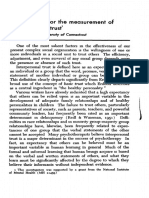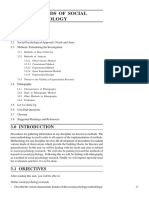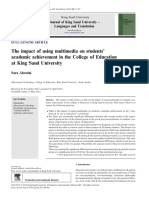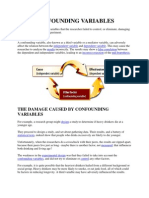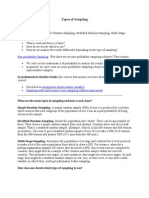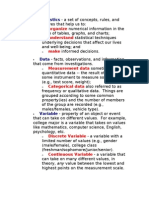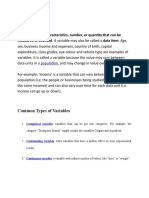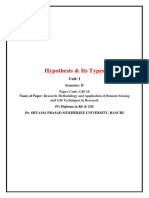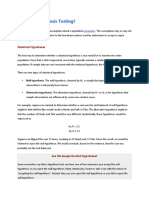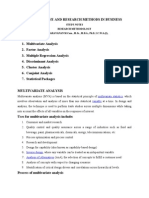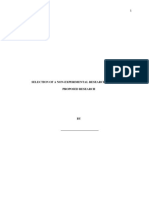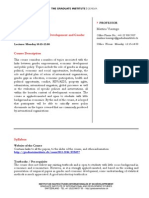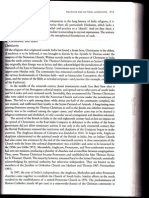Partial Correlation
Partial Correlation
Uploaded by
Sanjana PrabhuCopyright:
Available Formats
Partial Correlation
Partial Correlation
Uploaded by
Sanjana PrabhuOriginal Description:
Copyright
Available Formats
Share this document
Did you find this document useful?
Is this content inappropriate?
Copyright:
Available Formats
Partial Correlation
Partial Correlation
Uploaded by
Sanjana PrabhuCopyright:
Available Formats
Partial Correlation QARM
The goal of science is to identify relationships among variables. Ideally, the goal is to identify
casual relationships. If X, then Y??? One of the conditions necessary for causality is isolation.
A relationship between X and Y must persist after all other influences on Y have been ruled out.
In research, control means control of variance or in short removal of desired factors. In examining
the relationship between X (an IV*) and Y (a DV**), we want to control for an extraneous***
variable Z. The goal is to remove Zs influence on Y, such that Z accounts for no systematic variation
in Y scores
A partial correlation is a correlation Between two variables (X and Y) in which the effects of a third
variable(Z) Have been removed from both X and Y The correlation between the part of X that is
independent of Z with the part of Y that is independent of Z.
This type of analysis helps spot spurious correlations (i.e. correlations explained by the effect of
other variables) as well as to reveal hidden correlations - i.e correlations masked by the effect of
other variables. The central concept in partial correlation analysis is the partial correlation
coefficient
between variables x
The partial correlation coefficient
between x and y adjusted for z may be computed from the
pairwise values of the correlation between variables x ,y, and z and y , adjusted for a third variable
z.
*IV= Independent variable, DV**= Dependent variable
Extraneous variable***= undesirable variables that influence the relationship between the variables that an
experimenter is examining
Partial Correlation QARM
Example: It has been seen people who got money for health checkup , they are more likely to visit
doctor for checkup henceforth they are more likely to diagnosed with diseases
(Refer health_funding.sav file in SPSSs Sample folder)
BIVARIATE CORREALTION
PARTIAL CORRELATION (removing effect : Visits to health care)
You might also like
- A New Scale For The Measurement of Interpersonal Trust : Julian B. Rotter, University of ConnecticutDocument16 pagesA New Scale For The Measurement of Interpersonal Trust : Julian B. Rotter, University of ConnecticutMarielle LituanasNo ratings yet
- One Independent - Two Group DesignDocument26 pagesOne Independent - Two Group DesignAPRIL ATHENA TORREGOSANo ratings yet
- Experimental DesignDocument11 pagesExperimental Designtangent12100% (1)
- Measurement and Data Collection MethodsDocument28 pagesMeasurement and Data Collection MethodsShafiq Ur RahmanNo ratings yet
- Unit-3 Methods in Social PsychologyDocument21 pagesUnit-3 Methods in Social PsychologyAnanya NarangNo ratings yet
- Phi CoefficientDocument1 pagePhi CoefficientBram HarunNo ratings yet
- HypothesisDocument22 pagesHypothesisAnonymous kTVBUxrNo ratings yet
- 16.1 Latent Variable ModerationDocument6 pages16.1 Latent Variable ModerationMarium KhanNo ratings yet
- Module 3 A - Research DesignDocument22 pagesModule 3 A - Research DesignsafssimNo ratings yet
- Multiple Regression - D. Boduszek - HUD PDFDocument37 pagesMultiple Regression - D. Boduszek - HUD PDFDaniel MoyaNo ratings yet
- Al-Saadi - Demystifying Ontology and Epistemology in ResearchDocument11 pagesAl-Saadi - Demystifying Ontology and Epistemology in ResearchSujal FoodsNo ratings yet
- 1 s2.0 S2210831912000033 Main PDFDocument8 pages1 s2.0 S2210831912000033 Main PDFlyubovshankarNo ratings yet
- FORMAT FOR RESEARCH PROPOSAL AND REPORT WRITING Dec. 2010 (1) Dr. KidomboDocument10 pagesFORMAT FOR RESEARCH PROPOSAL AND REPORT WRITING Dec. 2010 (1) Dr. KidomboMartin Mutua100% (2)
- ConfoundingDocument2 pagesConfoundingSaad Murtaza KhanNo ratings yet
- Experiment ResearchDocument13 pagesExperiment ResearchmazorodzesNo ratings yet
- Inferential StatisticsDocument23 pagesInferential StatisticsAki StephyNo ratings yet
- Types of SamplingDocument3 pagesTypes of SamplingAwneesh Pratap Singh Chauhan100% (1)
- Central Tendency: Mode, Median, and MeanDocument15 pagesCentral Tendency: Mode, Median, and MeanKrung KrungNo ratings yet
- RPE Chapter1 - Philosophy and EthicsDocument32 pagesRPE Chapter1 - Philosophy and EthicsVijay SinhaNo ratings yet
- Participant Observation and NonDocument4 pagesParticipant Observation and NonWondwosen TilahunNo ratings yet
- Extraneous VariablesDocument3 pagesExtraneous VariablesAmna MazharNo ratings yet
- Corelational ResearchDocument6 pagesCorelational ResearchAnzala Sarwar100% (1)
- Biological Causal FactorsDocument6 pagesBiological Causal FactorsAmandeep DahiyaNo ratings yet
- Sample DesignDocument7 pagesSample DesignShubhankar GuptaNo ratings yet
- Analysis of Co-Variance (ANCOVA) and Multivariate Analysis of Co-Variance (Mancova)Document37 pagesAnalysis of Co-Variance (ANCOVA) and Multivariate Analysis of Co-Variance (Mancova)AC Balio100% (1)
- ValidityDocument16 pagesValidityNinasakinah Mp ArzNo ratings yet
- Identifying Types of VariablesDocument5 pagesIdentifying Types of VariablesAnonymous LusWvyNo ratings yet
- An Introduction To Exploratory Factor AnalysisDocument6 pagesAn Introduction To Exploratory Factor AnalysisAJayNo ratings yet
- Correlation DesignDocument43 pagesCorrelation DesignPuru TiwariNo ratings yet
- Research MethodologyDocument32 pagesResearch Methodologymuneerpp80% (5)
- Statistics: Organize UnderstandDocument9 pagesStatistics: Organize UnderstandJaved KaloiNo ratings yet
- Common Types of VariablesDocument5 pagesCommon Types of VariablesTd Devi AmmacayangNo ratings yet
- Qualitative Vs QuanitativeDocument8 pagesQualitative Vs Quanitativenian6789No ratings yet
- Role of Statistics in PsychologyDocument4 pagesRole of Statistics in PsychologyDevika RaniNo ratings yet
- Steps of Literature ReviewDocument5 pagesSteps of Literature Reviewaflsldrzy100% (1)
- Experimental ResearchDocument1 pageExperimental ResearchCharmen Diaz RamosNo ratings yet
- SPSSDocument24 pagesSPSSurshameerNo ratings yet
- Kinn (2005) Integrating Qualitative and Quantitative Research MethodsDocument20 pagesKinn (2005) Integrating Qualitative and Quantitative Research MethodsJamison SampaioNo ratings yet
- Research MisconductDocument3 pagesResearch MisconductĐi-enNờ-piNo ratings yet
- Independent T-Test For Two SamplesDocument3 pagesIndependent T-Test For Two SamplesJohn ChenNo ratings yet
- Recommended Sample Size For Conducting Exploratory Factor AnalysiDocument11 pagesRecommended Sample Size For Conducting Exploratory Factor AnalysimedijumNo ratings yet
- Hypothesis & Its TypesDocument14 pagesHypothesis & Its Typesshahnawaz ahmed100% (1)
- Threats To Internal ValidityDocument13 pagesThreats To Internal ValidityDani PhilipNo ratings yet
- What Is Hypothesis TestingDocument18 pagesWhat Is Hypothesis TestingShanna Basallo AlentonNo ratings yet
- N503 Non-Experimental WK 5Document23 pagesN503 Non-Experimental WK 5asghaznavi100% (1)
- AncovaDocument18 pagesAncovaJoanne LewNo ratings yet
- Chapter 3 Psycho Metrics Reliatility ValidityDocument23 pagesChapter 3 Psycho Metrics Reliatility ValidityUzaima SiddiquiNo ratings yet
- Research Design Elements and TypesDocument9 pagesResearch Design Elements and TypesSMiley XeroxNo ratings yet
- Likert ScaleDocument2 pagesLikert ScaleIvani KatalNo ratings yet
- Reliability and ValidityDocument33 pagesReliability and ValidityKamal SahimNo ratings yet
- Linear RegressionDocument53 pagesLinear RegressionJonesius Eden ManoppoNo ratings yet
- Research+Methodology+ +Multivariate+AnalysisDocument13 pagesResearch+Methodology+ +Multivariate+AnalysisSaigayathrti VembuNo ratings yet
- Steps Involved in Research Process - AbridgedDocument11 pagesSteps Involved in Research Process - AbridgedAnjie NathaniNo ratings yet
- 8 Steps To Improve Your Social AwarenessDocument2 pages8 Steps To Improve Your Social AwarenessangelitotimcangperaNo ratings yet
- Corelation and RegressionDocument5 pagesCorelation and RegressionN RamNo ratings yet
- Research Methods in Social ScienceDocument7 pagesResearch Methods in Social ScienceNicholas SiochaNo ratings yet
- The One-Sample T-Test: Department of BiostatisticsDocument8 pagesThe One-Sample T-Test: Department of BiostatisticsAfiq AsyraafNo ratings yet
- Chi Square TestDocument75 pagesChi Square Testdrmsupriya091159100% (1)
- Selection of A Non-Experimental Research Method For Proposed ResearchDocument5 pagesSelection of A Non-Experimental Research Method For Proposed ResearchsabaNo ratings yet
- Change of Origin and ScaleDocument11 pagesChange of Origin and ScaleSanjana PrabhuNo ratings yet
- Christ University, Bangalore-560029 II BA End Semester Examination March 2011Document1 pageChrist University, Bangalore-560029 II BA End Semester Examination March 2011Sanjana PrabhuNo ratings yet
- Geneva SyllabusDocument10 pagesGeneva SyllabusSanjana PrabhuNo ratings yet
- Yojana January 2014 PDFDocument68 pagesYojana January 2014 PDFNaveed Khan AbbuNo ratings yet
- History of Christianity in IndiaDocument1 pageHistory of Christianity in IndiaSanjana PrabhuNo ratings yet
- 8 45 1 PBDocument10 pages8 45 1 PBClara LimaNo ratings yet
- Kom of Of: of or of or &arma of andDocument2 pagesKom of Of: of or of or &arma of andSanjana PrabhuNo ratings yet
